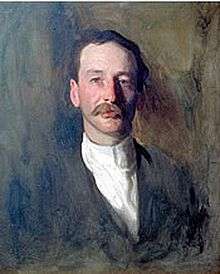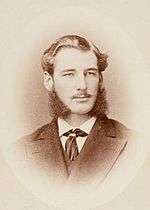Morton Prince
| Morton Prince | |
|---|---|
 American Pioneer in Dissociative Disorders | |
| Born |
December 21, 1854 Boston, Massachusetts, U.S. |
| Died |
August 31, 1929 (aged 74) Boston, Massachusetts, U.S. |
Morton Henry Prince (December 21, 1854 – August 31, 1929) was an American physician who specialized in neurology and abnormal psychology, and was a leading force in establishing psychology as a clinical and academic discipline.[1][2]
He was part of a handful of men who disseminated European ideas about psychopathology, especially in understanding dissociative phenomenon; and helped found the Journal of Abnormal Psychology in 1906, which he edited until his death.
Life
Morton Prince came from a wealthy Boston family and was involved in the social and intellectual life of that city. He went to private schools and then to Harvard College. He obtained his medical degree from Harvard Medical School in 1879. After Harvard, he took a "Grand Tour" of Europe, a near requirement for upper-class Americans at that time. It was in Paris that he visited Jean Martin Charcot at the Salpêtrière. He was quite impressed with Charcot's theories but returned to Boston to set up an otolaryngology practice. However, the spell of the charismatic Charcot was strong and he quickly switched his practice to neurology, and even adopted Charcot’s showmanship for teaching his classes.

He married Fannie Lithgow Payson, daughter of Arthur Lithgow Payson and Claire Endicott Peabody. They had at least two children, Claire Morton Prince, born about 1885, and Morton Peabody Prince, born August 6, 1888.
During the First World War at Hotel Lotti, Paris, France, Dr Prince was the director of an information bureau and home[3][4] intended for soldiers and sailors from Massachusetts.
Work
He became a devotee and avid proponent in the use of suggestion in treating mental illnesses in the United States and drew around him all the important practitioners in the burgeoning field of abnormal psychology of that time: Boris Sidis, James Jackson Putnam, William James, G. Stanley Hall, to name but a few. He became the American expert in dissociative disorders, which he also called multiple personality disorder.[5]
He published numerous accounts of cases, both in the academic press and the popular press. His most famous case was that of Christine Beauchamp, detailed in The Dissociation of a Personality (1906), which caused some consternation, due both to the sensational nature of the cases presented and to the convoluted prose style: "There was over her spine a 'hypnogenetic point', pressure upon which always caused a thrill to run through her that weakened her will and induced hypnotic sleep".[6]
Prince maintained an active professional life, not only with his psychopathologic studies but as practicing physician as well. He was a prolific writer, publishing some 14 books and numerous essays. He wrote mostly on dissociation and abnormal psychology but also applied his understanding of the unconscious to the politics of his day. Though his psychological ideas never took hold, he remained an eminent figure, Carl Jung for example contributing to his festschrift of 1925, Problems of Personality: Studies Presented to Dr. Morton Prince.[7] Prince founded the Harvard Psychological Clinic in 1927, only two years before his death. That clinic established a major American stronghold for wide-ranging psychological researches into personality that included a number of the luminaries of that field (Henry Murray, Gordon Allport, and Robert W. White), who all became famous extending the ideas that Prince first taught them.
Prince was like many prominent men of psychological science at the turn of the 20th century who have become obscure. They were captivated by the new science of mental life that attempted to wrestle psychopathology from the clutches of moralism that deemed it a degeneracy or from medicine that saw a heredity degeneracy, but had not yet developed an overarching theory. Prince stressed the importance of the subconscious to hysterical symptoms at the same time as Freud, but he was critical of psychoanalysis - arguing to Putnam for example that "You are raising a cult not a science"[8] - and preferred to outline his idiosyncratic position that never became popular. His groundbreaking work on personality became famous via Henry Murray, who took over as director of the Clinic and worked on elaborating it into a more systematic and approachable manner.
Skepticism
Prince was skeptical of paranormal claims and believed such experiences could be explained psychologically (see anomalistic psychology). He was an early member of the American Society for Psychical Research and a long-standing member of the Society for Psychical Research.[9][10][11] He was one of the first researchers to make a scientific study of crystal gazing.[12]
Selected publications
- Prince, M. (1885). The Nature of Mind and Human Automatism. Philadelphia, Lippincott.
- Prince, M. (1906). The Dissociation of a Personality. New York: Longmans, Green, & Co. Second edition (1908)
- Prince, M. (1909). Psychotherapeutics: A Symposium. Boston: R. G. Badge.
- Prince, M. (1909). My Life as a Dissociated Personality Prince, M (Ed.). Boston: R. G. Badger.
- Prince, M. (1915). The Psychology of the Kaiser: A Study of his Sentiments and his Obsessions London: Unwin Ltd.
- Prince, M. (1915). The Unconscious: The Fundamentals of Human Personality, Normal and Abnormal. New York, Macmillan.
- Prince, M. (1929). Clinical and Experimental Studies in Personality. Cambridge, MA: Sci-Art.
- Prince, M. (1975). Psychotherapy and Multiple Personality: Selected Essays. Hale, Jr., N. G. (Ed.). Cambridge, MA: Harvard University Press. ISBN 0-674-72225-6
See also
References
- ↑ Taylor, EW. (1929). Morton Prince, M.D., LL.D. 1854-1929. Arch NeurPsych. 22(5):NP
- ↑ Brown, Sanger. (1929). Morton Prince. Psych Quar 3: 639.
- ↑ http://www.culture.gouv.fr/public/mistral/memsap_fr?ACTION=CHERCHER&FIELD_98=MCPER&VALUE_98=%20Morton&DOM=All&REL_SPECIFIC=3
- ↑ "Base Mémoire : Archives photographiques". www.culture.gouv.fr. Archived from the original on April 26, 2016. Retrieved 2016-07-09.
- ↑ Rieber, R. W. (1999). Hypnosis, false memory, and multiple personality: A trinity of affinity. History of Psychology 10: 3-11.
- ↑ Prince, quoted in Richard Gregory ed., The Oxford Companion to the Mind (1987) p. 198
- ↑ Henri Ellenberger, The Discovery of the Unconscious (1970) p. 700 and p. 743
- ↑ Quoted in Brenda Maddox, Freud's Wizard (2006) p. 93
- ↑ Shea, Daniel. (2012). The Patience of Pearl: Spiritualism and Authorship in the Writings of Pearl Curran. University of Missouri. p. 10
- ↑ Valsiner, Jaan; Veer, Rene van der. The Social Mind: Construction of the Idea. Cambridge University Press. p. 70. ISBN 0-521-58036-6
- ↑ "Morton Prince". Biographical Dictionary of Parapsychology. Retrieved 28 July 2016.
- ↑ Zusne, Leonard; Jones, Warren H. (1989). Anomalistic Psychology: A Study of Magical Thinking. Lawrence Erlbaum Associates, Inc. p. 116. ISBN 978-0-805-80507-9 "Morton Prince (1898, 1922) was an early investigator of crystal gazing and one of the few to ever subject it to scientific scrutiny. He found that the images may be forgotten memory images, that with susceptible subjects the crystal ball could be dispensed with, and that scrying seemed to occur against a background of psychopathology."
Further reading
- Hale, Jr., N. G. (1971). Freud and the Americans: The Beginnings of Psychoanalysis in the United States, 1876-1917. New York: Oxford University Press. ISBN 0-19-501427-8
- Mitchell, T. W. (1930). Dr Morton Prince. Journal of the Society for Psychical Research 25: 42-43.
- Murray, H. A. (1956). Morton Prince: Sketch of his Life and Work. Journal of Abnormal and Social Psychology, 52, 291-295.
- Oltmanns, T. F. and Mineka, S. (1992). Morton Prince on Anxiety Disorders: Intellectual Antecedents of the Cognitive Approach to Panic? Journal of Abnormal Psychology, 101, 607-610.
- Rosenzweig, S. (1987). Sally Beauchamp's Career: A Psychoarcheological Key to Morton Prince's Classic Case of Multiple Personality. Genetic, Social, and General Psychology Monographs 113: 5-60.
- White, R. W. (1992). Who was Morton Prince? Journal of Abnormal Psychology, 101, 604-606.
External links
| Wikimedia Commons has media related to Morton Prince. |
- The dissociation of a personality; a biographical study in abnormal psychology (1906) on the Internet Archive.
- American Kaleidoscope article by George Prochnik on Prince, including comprehensive links to all his public domain online works.
- Morton Prince by John Singer Sargent (in public domain) courtesy of John Singer Sargent Virtual Gallery.